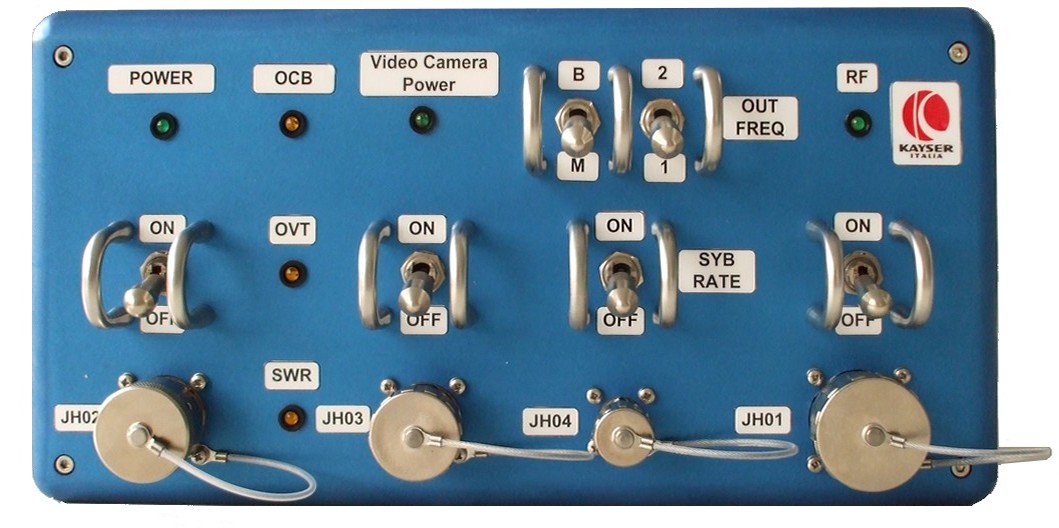Culumbus
 A DATV (digital amateur television) transmitter is installed in the Columbus module of the International Space Station (ISS). This transmitter is dubbed “Ham Video”.
A DATV (digital amateur television) transmitter is installed in the Columbus module of the International Space Station (ISS). This transmitter is dubbed “Ham Video”.
Main characteristics :
Downlink frequencies: 2.422 GHz, 2.437 GHz
Contingency frequencies : 2.369 GHz, 2.395 GHz
DVB-S like signal (without PMT tables)
Symbol rates: 1.3 Ms/s, 2.0 Ms/s
FEC : ½
Video PID = 256
Audio PID = 257
Antennas: ARISS 41 and ARISS 43 patch antennas on the nadir of Columbus
RF radiated power : approximately 10 W EIRP
Ham Video operates with a Canon XF-305 camera.
Commissioning
Commissioning of the Ham Video transmitter was performed April – March 2014. All four frequencies and two symbol rates were checked with each of the two antennas.
For each commissioning step, US astronaut Michael Hopkins transmitted video and audio during a pass over the Matera ground station. The Matera VLBI station is located at the Italian Space Ageny’s ‘Centro di Geodesia Spaziale G. Colombo’ (CGS) near Matera, a small town in the south of Italy.
The final commissioning test was performed by JAXA astronaut Koichi wakata, using configuration 4 for optimum results:
2.395 GHz
2.0 Ms/s
The signals were received by several ground stations and streamed to the BATC server (British Amateur Television Club).
Ham TV streams are identified ISS1 – 5. The BATC server is available at http://www.batc.tv
Blank transmission
When "Blank Transmission" is operational, Ham Video transmits a continuous DATV signal with the camera turned off. Ground stations receive a black image and audio at zero level. This Blank Transmission will go on till August 6, 2014.
A « blank » DVB-S signal contains all the data of normal DVB-S. The information tables describing the content and the content itself, i.e. the video (black) and the audio (silence), are the same as for the image and the sound produced by a camera.
Receiving a black image and silent sound may seem uninteresting but, from a technical perspective, the digital signal offers an important source of information.
Even without decoding, several measurements of the received signal provide valuable information:
analogic HF signal strength (dBm)
analogic Signal/Noise ratio (dB)
digital Signal/Noise ratio = MER (dB)
error/correction ratio = Vber, Cber …
validation of the received transport stream = TS
Reception Reports
Ground stations with S-band capability can provide valuable information.
Basic data such as:
noise level without signal
AOS time (UTC)
maximum signal level during pass
LOS time (UTC)
can be reported by ground stations without the need of DATV hard- and software. A reporting facility is available here : Ham Video Reporting
Windows computer with TechnoTrend TT S2-1600 card and Tutioune software
A Windows computer with TT S2-1600 receiver card can be used for Ham Video reception.
The Tutioune software, developed by Jean Pierre Courjaud F6DZP, measures and records the Ham Video signals second per second:
HF signal level
digital Signal/Noise level = MER (dB)
error/correction = Vber
validation of the received transport stream = TS
The recorded file can be examined and forwarded to ARISS.
Better even, the data can be forwarded during an ISS pass to the TiouneMonitor on the www.vivadatv.org website. In other words, the data can be observed worldwide, real time.
Tutioune also shows the constellations during signal reception (see HamTV Bulletin #4). The TS stream can be recorded, but this is less interesting since richer information is already available.
Tutioune also decodes the DVB tables and provides the PIDs and the channel name (« HAMTV ») recovered from theSDT table.
